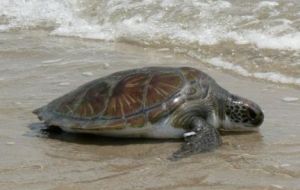MercoPress. South Atlantic News Agency
Cold waters strand migrating green sea turtles on Uruguayan beaches
 Almost a hundred have been recovered suffering most from hypothermia
Almost a hundred have been recovered suffering most from hypothermia A record number of sea turtles are turning up on Uruguayan beaches along the Atlantic Ocean and Río de la Plata suffering from cold shock and hypothermia.While specialists are still investigating the causes, they speculate that an abrupt change in sea temperature may have prevented the green sea turtles (Chelonia mydas) from migrating to warmer waters
The green sea turtle, classified as an endangered species by the International Union for Conservation of Nature (IUCN), normally grows and develops on the coasts of Uruguay and then migrates to Brazil in the winter in search of warmer waters.
The turtles are commonly spotted on the rocky points along the Atlantic coast in the departments (provinces) of Rocha and Maldonado, although they can also be found on the beaches along the River Plate.
Adult specimens can grow to up to a meter and a half in length and weigh up to 500 kilograms. But the green sea turtles that visit the coasts of Uruguay are juveniles, measuring around 40 centimetres in length.
“There have been records in the past of beached turtles due to cold winter temperatures, but the average was around 10 turtles during the entire winter,” Andrés Estrades, a specialist at the Karumbé sea turtle centre, told Tierramérica. “We had never reached such a high number before (100), and the cold weather has only just begun.”
So far this winter, the centre has taken in 32 rescued turtles, young specimens between the ages of two and 12 years and weighing between four and 15 kilograms, said Estrades. A team of Karumbé volunteers is working hard to diagnose their condition and help them to recover.
The rest of the roughly 100 rescued turtles have been distributed among similar centres in Rocha and Maldonado, and around 20 have been discovered dead.
The sea water temperature is currently 10 degrees. While this is not a record low temperature, it is below the average for this time of year, which is 12 degrees. According to Estrades, this difference could be fatal for some turtles.
“We are seeing changing trends in maximum and minimum temperatures, possibly due to climate change. We had a rather warm autumn, and winter arrived very suddenly. This might have disoriented the turtles,” he said.




Top Comments
Disclaimer & comment rules-

-

-

Read all comments“We are seeing changing trends in maximum and minimum temperatures, possibly due to climate change.”
Jul 25th, 2012 - 08:56 am 0Black is white, cold is hot and keep taking the money.....
i personally saw one on a beach near Piriápolis its a shame this is happening.
Jul 26th, 2012 - 01:09 am 0NASA Goddard have visualised the world oceanic current flows: http://gcaptain.com/perpetual-ocean-artistic-worlds/?43332
Jul 26th, 2012 - 03:50 pm 0Worth checking out.
The S. Atlantic surface flows from the Antarctic strengthen in the winter (now), skirting TFI and moving to the continental landmass off Uraguay. This can bring to the Brasilian coast & 'kill' penguins and also halt and kill turtles, especially if regional and local temperature flux is high - as indicated in this article.
Commenting for this story is now closed.
If you have a Facebook account, become a fan and comment on our Facebook Page!